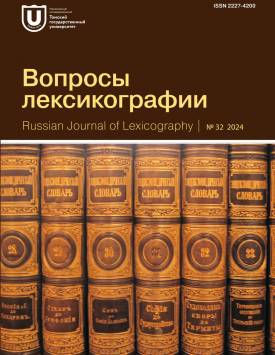On the notion “normative dictionary” in Russian explanatory lexicography: Normative-stylistic and orthologic traditions
The authors analyse the parameters and the application of the notion “normative dictionary” in Russian explanatory lexicography. It is established that two traditions of interpretation are combined in this notion: the normative-stylistic one (L.V. Shcherba, V.V. Vinogradov, Yu.S. Sorokin, and others) and the orthologic one (D.N. Ushakov, S.I. Ozhegov, L.I. Skvortsov, and others). The genesis and the specifics of both interpretations are uncovered. Both traditions arose in Soviet lexicography in the 1930s, when this term appeared in common use. An explanatory dictionary’s normativity as a normative-stylistic category, which is aligned with the description of literary vocabulary extracted from classic texts in all its stylistic diversity, was comprehended in lexicographers’ works in the 1940s-1980s. In this period, the theoretical problems were being resolved in Russian lexicography, and the challenge of creating a normative-stylistic dictionary was issued. On the contrary, the comprehension of an explanatory dictionary’s normativity as a prescription of correct pronunciation, spelling, conjugation, etc. appears along with the need in a reference book for correct language use addressed to a wide audience. This tradition arose when D.N. Ushakov’s Russian Explanatory Dictionary (1934-1940) was being created and was finally established in Russian lexicography after the appearance of S.I. Ozhegov’s one-volume Dictionary of the Russian Language (1949). One of the reasons why two different traditions were combined in the current comprehension of the term “normative dictionary” was the lack of research on this problem in the 1930s when the term itself came into scientific use. As an evidence for the fact that the term was understood in various ways, the authors show some materials taken from a discussion dated by 1939 (first published in 2023) with S.P. Obnorskiy, D.N. Ushakov, V.I. Chernyshev, L.V. Shcherba, and others among its participants. Most of them emphasized the complexity of the task to create a normative explanatory dictionary that was due to the vagueness of the category of normativity itself. Another reason why two terminological traditions were mixed in one term was the popularity of the genre of one-volume prescriptive dictionary (like Ozhegov’s one) and the transfer of its normative specificity onto other Russian explanatory dictionaries. This was supported by the orthological understanding of norm (language standard) that was deeply elaborated in Russian linguistics in the 1950s-1980s. The authors conclude that nowadays, due to predominance of the orthological interpretation of the explanatory dictionary’s normativity, it is necessary to provide an in-depth investigation into the specifics of the category of normativity for the explanatory dictionary of the great type, which is aimed at describing the wide stylistic diversity of Russian vocabulary. The authors declare no conflict of interests.
Keywords
explanatory lexicography, literary norm, language standard, normative explanatory dictionary, history of Russian lexicographyAuthors
| Name | Organization | |
| Priemysheva Marina N. | Institute for Linguistic Studies, Russian Academy of Sciences | mn.priemysheva@yandex.ru |
| Stukova Ekaterina G. | Institute for Linguistic Studies, Russian Academy of Sciences | e.g.stukova@gmail.com |
References

On the notion “normative dictionary” in Russian explanatory lexicography: Normative-stylistic and orthologic traditions | Voprosy leksikografii – Russian Journal of Lexicography. 2024. № 32. DOI: 10.17223/22274200/32/1
